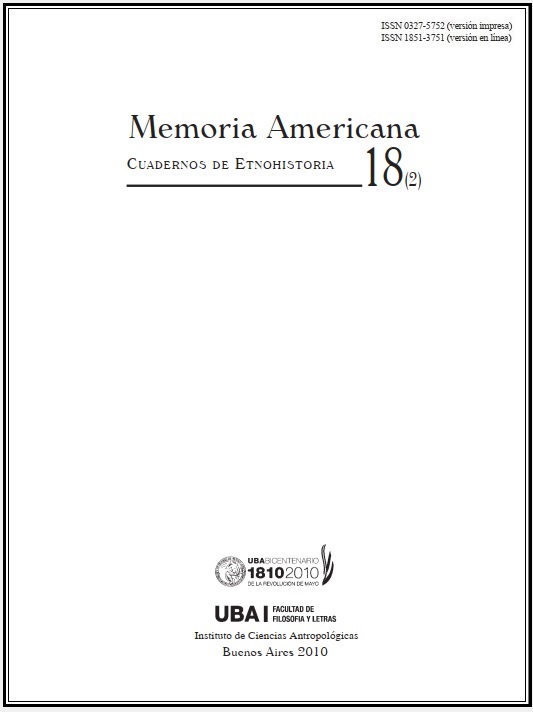Socially and culturally ambiguous: criollo-mestizo population in the 17th century, Tucumán
Abstract
This article analyzes the influence of indigenous societies on the descendants of Spanish conquistadors, known as criollos. The subject is approached through a case study which shows how a faction of San Miguel de Tucumán town council (cabildo) tried to prevent the admission of Juan Jordán de Trejo as deputy governor (teniente de gobernador). He belonged to the Melián de Leguizamo y Guevara family, owners of encomiendas in Tafí, but his lower lineage made him served as the town’s administrator. Specific characteristics of his intercultural persona resembling a mirror image -referred to as Spanishization or Westernization of the Indians- will be studied, including his fluency in the indigenous language, his knowledge of pre-Hispanic societies and their territories and his illiteracy. His role as interethnic mediator (passeur culturel), and the advantages and drawbacks such a profile presents at different junctures, for social and political participation in the dominant group, will also be analyzed.Downloads
References
Alberro, Solange [1992] 2000. Del gachupín al criollo. O como los españoles de México dejaron de serlo. México, El Colegio de México.
Arana, María Margarita 2009. El problema de los Tenientazgos: Enfrentamientos y solidaridades entre las “elites” de San Miguel de Tucumán en 1564. Ponencia presentada en las XII Jornadas Interescuelas-Departamentos de Historia, Bariloche, octubre 2009. Ms.
Arenas, Patricia, Bárbara Manasse y Estela Noli 2007. Paisajes y procesos sociales en Tafí del Valle. En Arenas, P; B. Manasse y E. Noli (Comps.); Paisajes y procesos sociales en Tafí. Una mirada interdisciplinaria desde el Valle. (Tucumán, Argentina): 9-54. Tucumán, Imprenta de la Universidad Nacional de Tucumán.
Bixio, Beatriz y Eduardo Berberián 1988. Modos de ocupación y explotación económica del Valle de Tafí en los siglos XVI y XVII. En Berberian, E. (Dir.); Sistemas de asentamientos en el Valle de Tafí: 111-144. Córdoba, Comechingonia.
Boixados, Roxana 1997. Herencia, descendencia y patrimonio en la Rioja colonial. Andes 8: 199-22.
Boixados, Roxana 1999. Trasmisión de bienes en familias de elite: los mayorazgos en La Rioja colonial. Andes 10: 51-79.
Boixados, Roxana 2004. Documento de trabajo: No ha tenido hijo que más se le parezca así en la cara como en su buen proceder. Bastardía y mestizaje en La Rioja colonial. Taller de discusión “El mestizaje como problema de investigación”. Universidad Nacional de Quilmes. Ms.
Brading, David 1991. Orbe indiano. De la monarquía católica a la república criolla, 1492-1867. México, Fondo de Cultura Económica.
Carrizo, Juan Alfonso 1937. Cancionero popular de Tucumán, I. Tucumán, Universidad Nacional de Tucumán.
Castañeda Delgado, Paulino y Juan Marchena Fernández 1992. La jerarquía de la iglesia en Indias: el episcopado americano. 1500-1850. Madrid, Mapfre.
Coello de la Rosa, Alexandre 2008. Criollismo, redes clientelares y la Compañía de Jesús: La familia Garavito Illescas en el Perú colonial. Nuevos Mundos, Mundos Nuevos. Coloquios. http://nuevomundo.revues.org/index19812.html
Contreras, Manuel 2000. Criollismo lingüístico en el español de Chile en el periodo colonial Estudios Filológicos 35: 41-59.
Cruz, Rodolfo 1997. La construcción de las identidades étnicas en el Tucumán colonial: Los amaichas y los tafíes en el debate sobre “su” verdadera estructura étnica. En Lorandi, A. M. (Dir.); El Tucumán colonial y Charcas I: 253-282. Buenos Aires, Facultad de Filosofía y Letras, Universidad de Buenos Aires.
Chamosa, Oscar 2008. Indigenous or criollo: The Myth of White Argentina in Tucumán’s Calchaquí Valleys. Hispanic American Historical Review 88 (1): 71-106.
Ferreiro, Juan Pablo 1995. Tierras, encomiendas y elites: El caso de Jujuy en el siglo XVII. Anuario de Estudios Americanos LII: 189.214.
Ferreiro, Juan Pablo 1997. Aliados y herederos. Algunas consideraciones sobre la casa, la filiación y la herencia en el Jujuy del XVII. Andes 8: 77-101.
Garzón Maceda, Ceferino 1962. Economía del Tucumán. Economía natural y economía monetaria. Siglos XVI, XVII y XVIII Serie Histórica XXXV.
Glave, Luis Miguel 2007. Fray Alonso de Graneros Avalos y los naturales andinos: Debates sobre el destino de la sociedad colonial a inicios del siglo XVII. Cuadernos Interculturales 8: 15-50.
Kuznesof, Elizabeth Anne 1995. Ethnic and Gender Influences on ‘Spanish’ Creole Society in Colonial Spanish America. Colonial Latin American Review 4 (1): 153-176.
La Capra, Domick 1985. History & Criticism. Londres, Cornell University Press.
Lafaye, Jacques [1974] 1993. Quetzalcóatl y Guadalupe. La formación de la conciencia nacional en México. México, Fondo de Cultura Económica.
Larrouy, A 1923. Documentos del Archivo de Indias para la Historia del Tucumán. 1591-1700. Buenos Aires, Rosso.
Lavallé, Bernard 1978. Del ‘espíritu colonial’ a la reivindicación criolla o los albores del criollismo peruano. Histórica II (1): 39-61.
Lavallé, Bernard 1984. La rebelión de las alcabalas (Quito, julio 1592- abril 1593). Ensayo de interpretación. Revista de Indias 44: 141-173.
Lavallé, Bernard 1993. Las promesas ambiguas. Ensayos sobre el criollismo colonial en los Andes. Lima, Fondo Editorial/ Pontificia Universidad Católica del Perú.
Lizondo Borda, Manuel 1941. Documentos coloniales relativos a San Miguel y a la Gobernación del Tucumán Siglos XVII (1651-1684.) I (IV). Tucumán, Publicación de la Junta Conservadora del Archivo Histórico de la Provincia de Tucumán.
Lizondo Borda, Manuel 1942. Tucumán en los siglos XVI y XVII. Tucumán, Publicación de la Junta Conservadora del Archivo Histórico de la Provincia de Tucumán.
Lorandi, Ana María 2000. Las rebeliones indígenas. En Tandeter, E. (Dir.); La sociedad colonial. Nueva Historia Argentina II: 189-242. Buenos Aires, Sudamericana.
Lorandi, Ana María y Juan Pablo Ferreiro 1991. De la crisis a la estabilidad. La sociedad nativa de Tucumán a fines del siglo XVII y comienzos del XVIII. Memoria Americana 1: 57-102.
López, Cristina 1991. El derecho a las tierras en San Miguel del Tucumán, a la luz de la documentación de los siglos XVI y XVII. Cruz Ansata 14.
Massmann, Stefanie 2007. Casi semejantes: Tribulaciones de la identidad criolla en infortunios de Alonso Ramírez y cautiverio Feliz. Atenea 495: 109-125.
Noli, Estela 2001. Relaciones interétnicas en San Miguel de Tucumán siglo XVII. El mundo del trabajo. Tesis de Maestría. Universidad Nacional de Tucumán. Ms
Noli, Estela 2002 a. Especialización productiva de la mano de obra encomendada en la jurisdicción de San Miguel de Tucumán: indios carpinteros y carpinterías (siglo XVII). Revista de la Junta de Estudios Históricos de Tucumán 10: 161-210.
Noli, Estela 2002 b. Indios ladinos del Tucumán colonial: los carpinteros de Marapa. Andes 12: 139- 172.
Noli, Estela 2009. Mestizajes, identidad y oficio. San Miguel de Tucumán, siglo XVII. En Farberman J. y S. Ratto (Comps.); Historias mestizas en el Tucumán colonial y las pampas. Siglos XVII- XIX: 49-78. Buenos Aires, Biblos.
Palomeque, Silvia (Dir.) 2005. Actas del cabildo Eclesiástico. Obispado del Tucumán con sede en Santiago del Estero 1592-1667. Córdoba. Programa de Historia regional Andina CIFFyH, UNC.
Piossek Prebish, Teresa 1984. Relación Histórica de Calchaquí. Buenos Aires, Ediciones Culturales Argentinas. Ministerio de Educación y Justicia.
Ponce Leiva, Pilar y Arrigo Amadori 2006. Élites en la América Hispana: Balance bibliográfico (1992-2005). Nuevos Mundos Mundos nuevos. Bibliografías 2006. http://nuevomundo. revues.org/index1576.html
Poot-Herrera, Sara 1995. Los criollos: nota sobre su identidad y su cultura. Colonial Latin American Review 4 (1): 177-184.
Robledo, Nélida Beatriz 1999. La hacienda de los lules 1767-1773. En Segreti, C.; In memorian. Historia e historias II: 189-204. Córdoba, Centro de Estudios Profesor Carlos S. A. Segreti.
Robledo, Nélida Beatriz 2001. Los lules de San Miguel (siglos XVII y XVIII). Ms.
Rubio Durán, Francisco 1997. Tierra y ocupación en el área surandina. Las zonas de altura del Tucumán colonial. Siglo XVII. Sevilla, Aconcagua Libros.
Scott, James [1990] 2000. Los dominados y el arte de la resistencia. México, Era.
Schwartz, Stuart 1995. Colonial Identities and Sociedad de Castas. Colonial Latin American Review 4 (1): 185-201.
Copyright (c) 2010 Memoria Americana. Cuadernos de Etnohistoria

This work is licensed under a Creative Commons Attribution-NonCommercial-ShareAlike 4.0 International License.
Los derechos de autor son cedidos a Memoria Americana. Cuadernos de Etnohistoria, no obstante los autores podrán recuperarlos y reproducir su trabajo en otros medios o formatos previo envío de solicitud al Comité Editorial. En tales casos, deberá citarse a Memoria Americana. Cuadernos de Etnohistoria como primera publicación del trabajo y el mismo queda bajo una licencia Creative Commons CC BY NC SA 3.0 Attribution- Non Commercial -ShareAlike 3.0, la cual provee libre acceso inmediato a sus contenidos pues se rige por el principio según el cual hacer disponible -en forma gratuita- la investigación al público fomenta un mayor intercambio de conocimiento a nivel global.
Los autores deberán remitir el siguiente formulario de cesión de derechos y compromiso de originalidad:
Cesión de derechos y compromiso de originalidad
Al Comité Editorial de Memoria Americana, Cuadernos de Etnohistoria
Por la presente declaro ser el autor del trabajo titulado (nombre del artículo), el mismo es original y propio y no ha sido publicado en ningún formato o soporte con anterioridad.
En caso de ser aceptado para su publicación en Memoria Americana. Cuadernos de Etnohistoria (número/año) cedo los derechos editoriales que me corresponden por el aludido artículo para su publicación en todos los formatos que posea la mencionada revista.
Si quisiera publicar este artículo a través de otro editor o en otro lugar me comprometo a solicitar el correspondiente permiso por escrito al Comité Editorial de Memoria Americana. Cuadernos de Etnohistoria. De ser afirmativa la respuesta del Comité Editorial me comprometo a lo siguiente:
- especificar lugar, editorial y fecha de la primera publicación del artículo en la nueva publicación
- realizar esta republicación sólo luego de transcurridos un año calendario desde la fecha de la presente nota de cesión de derechos
FIRMA
Aclaración











